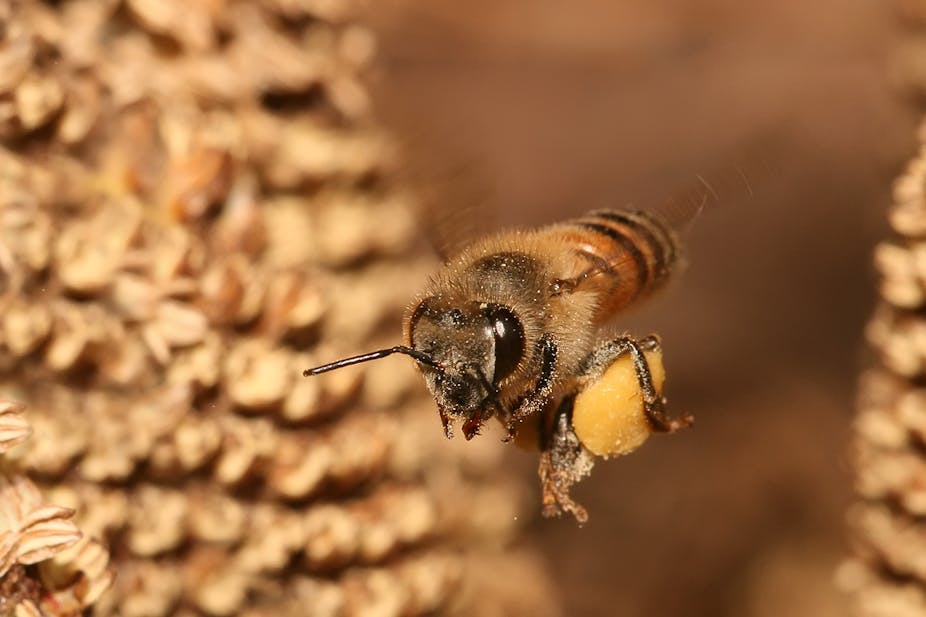Ancient woodlands and flower-rich meadows have disappeared to make way for agriculture and urbanisation, but attempts are being made to reverse the decline using “green” farming projects. The question is, are they working?
Known as agri-environmental schemes, under these farmers are paid to manage the land in ways that are more conducive to wildlife. They also bring benefits to the farm: encouraging species of birds and insects that control crop pests, and attracting more pollinators for flowering crops.
But trying to establish how effective these schemes are involves taking measurements by walking through fields – a laborious and time-intensive process that’s impossible to do on a large scale. Instead, we have found a way to recruit bees to do the work for us.
Each of the tens of thousands of bees within a hive is a little information-gathering machine that flies, rather than walks, similar sorties through the fields on our behalf collecting information. A bee that has found a good source of nectar or pollen will tell her nestmates, and she does so by using “waggle dance” language, a figure-of-eight move that indicates to others the distance and direction from the hive of flower patches that are of value to them.

Our research published in the journal Current Biology eavesdrops on this waggle dance communication between bees, so we can tell which areas they value for sources of nectar and pollen. Even though each bee knows only a fraction of the landscape, the colonies as a whole cover a lot of ground: bees from our study surveyed about 94km2. By combining the bees’ selected areas with the location of agri-environmental schemes we can establish which of those human efforts to improve the landscape impress pollinators.
What does the bee say?
And what do the bees prefer? We need to account for how bees rank a source of food. For both pollen and nectar, we know that foragers’ willingness to dance for the source increases with the quality of the treasure, whether that’s sugar-concentrated nectar or the protein-rich pollen. The worker bees out collecting also consider the distance to the food: can they get sufficient food from the corner store to not warrant travelling to the large supermarket many kilometres away? After accounting for the time and energy spent flying several kilometres back and forth, a flower patch considered high quality if near the hive may make for a poor meal if located further afield. So we too had to take the distance into account in our analysis and counteract it by giving greater weight to dances that indicate locations at greater distances.
The University of Sussex lies at the northeastern boundary of Brighton, so bees from the hives on campus have access to urban areas and open fields, and those fields that include agri-environment scheme areas. Perhaps the crown jewels in this landscape are Castle Hill National Nature Reserve to the southeast and Ditchling Beacon local nature reserve to the northwest.
After making allowances for distance, it turns out that the university campus bees ranked these first and second in preference. Overall, they preferred land managed under the UK agri-environmental schemes called Higher Level Stewardships, under which farmers set aside land and field margins on which to grow wildflowers and plants for the long term. Interestingly they seemed averse to land managed under another scheme, the Organic Entry Level Stewardships.
Efforts pay off for pollinators
So what do the bees choices tell us? The nature reserve areas most visited by bees are managed mainly to attract butterflies and moths, but as wildflower-rich chalk grasslands they are also attractive to honeybees. Clearly the conservation efforts pay off, as they provide pollinators with food which might be sparse in areas of more intensively managed rural lands.
The fact that bees prefer the nature reserves is proof that honeybee hives are capable of finding and indicating areas we suspect are good. The bees also liked some areas managed under agri-environmental schemes, which shows that the money given to farmers to manage their land with wildlife in mind is well spent – at least as far as bees are concerned. Hopefully, if our study is replicated at other locations we might learn more about which specific sets of plants or styles of land management benefit them most.
Our study shows that bees, due to their large foraging range and ability to carefully evaluate the quality of food available are good indicators of landscape quality. Studying where honey bees forage can reveal where benefits can be had for other insect pollinators too.
Watching the waggle dance could be used where building projects are underway, to ascertain the quality of land that may be lost. How useful is the land that might be lost to bees if the Thames Estuary Airport is built? Should we build that football stadium next to a nature reserve? Can the planting of flower-rich margins lessen our impact? Our method gives ecological consultants a tool to answer these and similar questions – we just have to listen to the bees.

